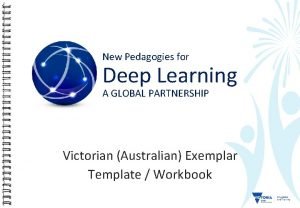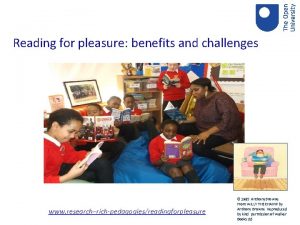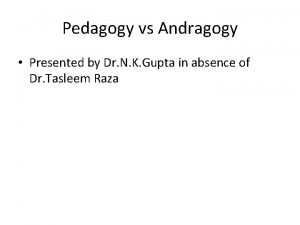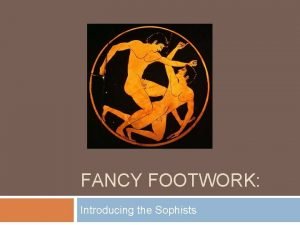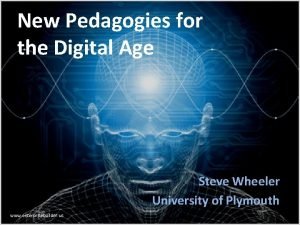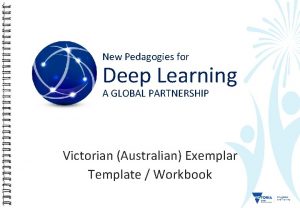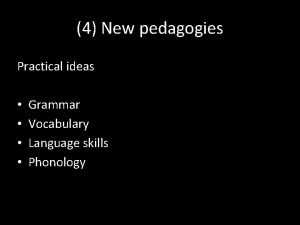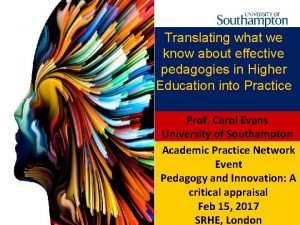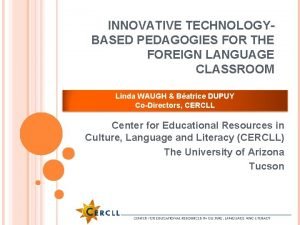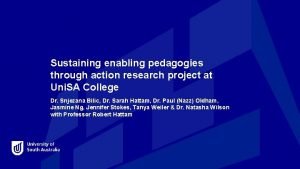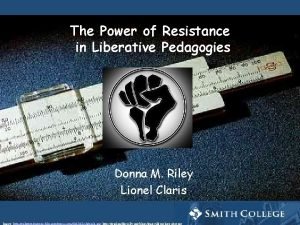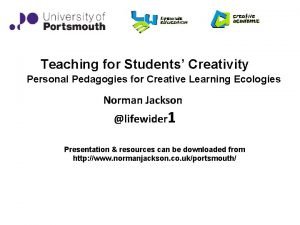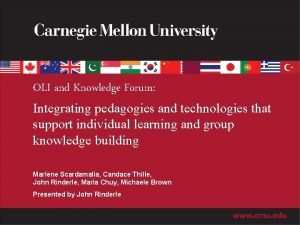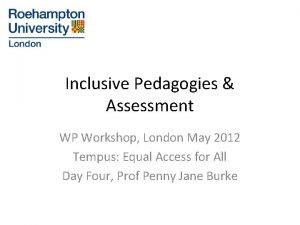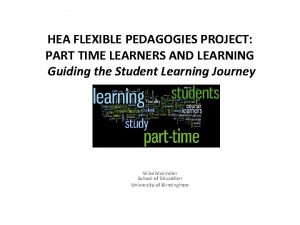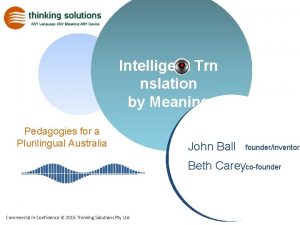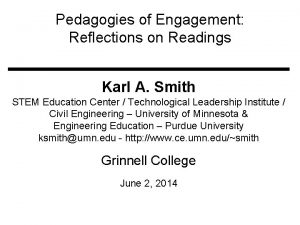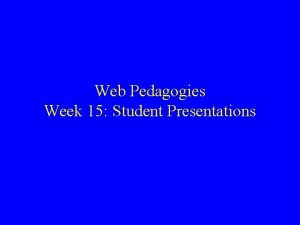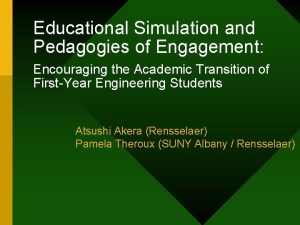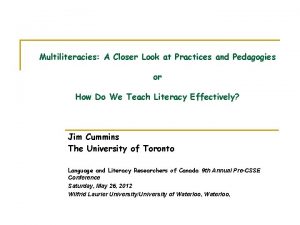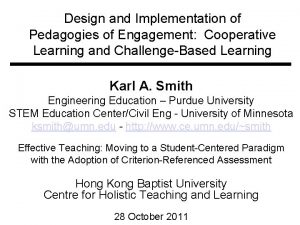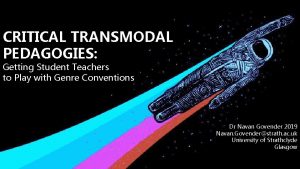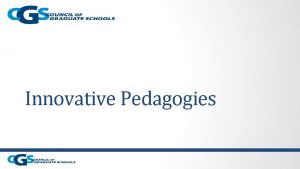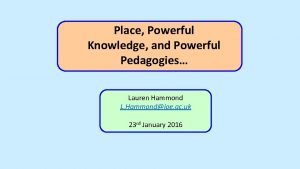O A P T New Pedagogies for Science





































































- Slides: 69

O A P T New Pedagogies for Science Teaching PER Techniques Evidence-Based Teaching Methods John Caranci STAO 2013

Birth of PER At the University of Arizona in early 70's a physics professor found when problems in assessments relied only on concepts without the mathematics students did very poorly. This was the birth of Physics Education Research.

How Different PER is researched based. The methods and pedagogies are not anecdotal. They are evidencebased teaching methods. There is a full research procedure to show the efficacy of the methods. Few Faculties of Education research on physics concept attainment and may do not research concept attainment in the sciences.

This is a Lecture?

The Lecture…. Physicists Seek To Lose The Lecture As Teaching Tool, Emily Hanford, National Public Radio, January 01, 2012 Is the Lecture Dead? Richard Gunderman, The Atlantic, Jan 29 2013, Twilight of the Lecture, Harvard Magazine, November-December 2013 The Death of the Lecture Michael Abrams, ASME. org, September 2012

Our Quiet Future!


What Counts It is not what the teacher does that counts – it is what the teacher gets the students to do. “WHO DOES THE WORK DOES THE LEARNING!”

Where Do We Look? The Parable of the Lamplight When you arrive home from a walk one very dark night you notice your keys are missing. Where would you look for them? You would look under the street lamp, because you would not find them in the dark otherwise.

And Sometimes… When you are strolling down the beach You Find: A Shinny Pebble

Nature of Science One person at the table pick up the hanger and put the strings to the tragus then hit object with it. Remaining people at the table describe their observations on the white board.

Whiteboard Technique Using dry erase white boards of personal size to indicate answers and results of deliberations. Use requires everyone to respond and therefor engage Psychological confidence indicated by body attitude and height of board. Teacher can easily survey class results

Keys Level – All science Teacher Effort – low Needs – Dry erase personal sized boards Uses - mathematical understanding, Problemsolving skills, relating to the real world, Think like a scientist, Reflecting on one's own learning, Self -confidence, Representing knowledge in multiple ways

First Law of Learning Those doing the work - do the learning If the teacher is talking the teacher is working therefore learning What individuals and groups do informs their learning and what they learn.

Ring and Chain Activity Observe the ring and chain interaction. Group discussion – How/why does this happen?

Using Your ABCD Cards A. The ring has an opening letting the chain through. B. Through slight of hand the chain is tied a different ring. The second ring is in John’s hand. C. The ring flips and sweeps up the chain. D. The human eye is too slow to catch the movement.

Teaching with Clickers are electronic devices that allow students to vote on multiple-choice questions and teachers to collect and display the results of voting instantaneously. It also requires full engagement by students. It enhances collaboration leading to better learning. Clickers are not really a teaching method, but a technology that can be used as a part of many different teaching methods, including Peer Instruction, TEFA, and Think-Pair-Share (see similar methods), etc. Can be substituted with inexpensive ABCD cards.

Keys Level – Any Science Teacher Effort – Low Needs – ABCD cards or clickers (with supporting software) Uses - Conceptual understanding of science content Can be adapted for: Problem-solving skills, Connecting conceptual and mathematical understanding, Coherent framework for science, Understanding how science relates to the real world, Think like a scientist, Reflecting on one's own learning, Self-confidence around science, Enjoyment of science, Representing knowledge in multiple ways

The Infinite Cheese Solve the following problem using any method you think appropriate. Imagine an infinite cheese. Imagine an infinitely large knife. When the knife cuts once there are then two infinite pieces. With two cuts there is four pieces. With three cuts there is eight pieces. The cuts are not parallel, not perpendicular, and no three cuts are along the same line, so, the forth cut provides a finite size piece that is bordered by the cuts. How many pieces are there after five cuts and after six cuts? (Bonus: Find the general formula where n, would be the number of cuts and p, the number of pieces)

Use the White Boards

But Come to a Consensus – You Must Agree Hold Up Your Boards

Field Problem Tube and Magnet Why does the magnet slow down in the tube or does it?

But Come to a Consensus – You Must Agree Hold Up Your Boards

Which Problem is More Difficult? Using your ABCD cards A. The first problem B. The second problem C. Both equal difficulty D. What problem?

Ranking Task Exercises that require students to engage in a comparison reasoning process: students rank variations of phenomenological situations on the basis of a specified quantity or quality and explain their reasoning. Ranking Tasks frequently elicit students' natural ideas about the behavior of systems rather than a memorized response, providing teachers with a way to gain important insights into students' thinking.

Keys Level – Junior and Senior Mathematics and Sciences Teacher Effort – low Needs – Sources for tasks Uses - Conceptual understanding of content

Tears of the Surgeon A surgeon attends a conference where they learn a new procedure that will improve survivability by 80%. When they go back to their home clinic they arbitrarily decide to keep doing the old method. Is this grounds for malpractice? Glenn Wagner (OAPT)

What About Lecture? Save a drowning man and/but tie your shoelaces. Walden by Henry David Thoreau

"We are all apprentices of a craft where no one ever becomes a master. " - Ernest Hemingway (1961)

Just-in-Time Teaching (Ji. TT) Students are asked questions, usually online, which both encourage preparation for the class and encourage students to come to class with a "need to know. ” Students respond online. Teachers use the responses to fine tune their presentation, and incorporate quotes from the student responses into the class.

Keys Level – All Subjects (not just Sciences) Teacher Effort – Medium/high Needs – Student home computers, online management and collection tools for online responses Uses - Conceptual understanding of science content , Connecting conceptual and mathematical understanding, Coherent framework for science, Understanding how science relates to the real world, Think like a scientist, Representing knowledge in multiple ways, Study skills Can be adapted for: Reflecting on one's own learning, Selfconfidence around science, Enjoyment of science, Autonomy

Interactive Class Demonstrations Active-learning worksheets designed to be used in large class environments. Students make predictions about the outcomes of science demonstrations using microcomputer-based laboratory equipment (probes), or physical demonstrations discuss their predictions in small groups, observe the results of the live demonstration, compare these results with their predictions, and attempt to explain the observed phenomena.

Keys Level – Secondary Science Teacher Effort – low Needs – Laboratory equipment for teacher/students to do demonstrations Uses - Conceptual understanding of content , Connecting conceptual and mathematical understanding, Representing knowledge in multiple ways

Interactive Simulations Ph. ET, Gizmos, and other simulations provide interactive, game-like environments which enable scientist-like exploration, connect to the real world, and include key visual models that experts use by, for example, making the invisible and providing multiple representations. Choosing ones with intuitive interface and minimal text, designed to give teachers control over how they are used in the classroom. Many are available for free!

Keys Level – junior and senior sciences Teacher Effort – low Needs – Internet connection, computers, flash, shockwave Uses - conceptual understanding, coherence, observation, Problem-solving skills, Designing experiments

Peer Instruction Interactive engagement in classes by replacing lectures with small group discussions of conceptual questions, followed by whole-class discussions. Students first think about and answer these questions individually; then discuss the explanations for their answers with their neighbors and come to agreement on the underlying.

Keys Level – All science Teacher Effort – low Needs – ABCD cards or clickers (with supporting software) Uses - Conceptual understanding of content, Connecting conceptual and mathematical understanding, Problem-solving skills, Enjoyment of science, Coherent framework for science, Understanding how science relates to the real world, Think like a scientist, Reflecting on one's own learning, Self-confidence around science, Representing knowledge in multiple ways

Cooperative Group Problem. Solving Students work in small groups using structured problem-solving strategy to solve complex context-rich problems that are too difficult for any one student to solve individually.

Keys Level – Secondary Science Teacher Effort – Medium Needs – Class restructuring, Large choice of multistep problems Uses - Problem-solving skills , Conceptual understanding of science content , Connecting conceptual and mathematical understanding, Understanding how science relates to the real world, Group work. Can be adapted for: Coherent framework for science, Think like a scientist, Self-confidence around science, Enjoyment of science, Representing knowledge in multiple ways

Context-Rich Problems Students work in small groups on short realistic (authentic) scenarios giving them a plausible motivation for solving the problem. These should be more complex than traditional problems. Reflect the real world, and may include excess information, or require the student to recall important background information.

Keys Level – All Sciences Teacher Effort – Medium Needs – Classroom Restructuring Uses - Problem-solving skills , Conceptual understanding of science content , Connecting conceptual and mathematical understanding, Coherent framework for science Can be adapted for: Understanding how science relates to the real world, Think like a scientist

Real. Time Science Real. Time science is a series of introductory laboratory modules that use computer data acquisition tools (microcomputer-based lab like probes) to help students develop science concepts and acquire laboratory skills. Besides data acquisition, computers are used for basic mathematical Modelling, data analysis, and simulations. Students construct their own models of phenomena based on observations and experiments.

Keys Level – All Sciences Teacher Effort – low Needs – Computers for student use in class, Lab equipment for student use - professional, Cost for students, Tables arranged for group work or work stations. Uses - Conceptual understanding of science content , Connecting conceptual and mathematical understanding, Laboratory skills, Representing knowledge in multiple ways.

Microcomputer-based Laboratories Laboratory activities that collect and present data graphically in real time, allowing students to get a direct intuitive sense of fundamental science concepts that cannot be observed directly.

Keys Level – All Sciences Teacher Effort – Medium Needs – Computers for student use in class, Lab equipment for student use – professional Skills, Probeware Uses - Connecting conceptual and mathematical understanding, Think like a scientist, Enjoyment of science, Designing experiments Research

Workshop Science Lessons and laboratories with sequenced activities. In a typical two-hour Workshop science class session, students work in groups of 3 or 4 to make and discuss predictions and then use equipment and computer tools for simple observations, data acquisition, visualization, analysis, and mathematical Modelling.

Keys Level – All science Teacher Effort – Medium Needs – Student Assistants, Projector in class, Computers for student use in class, Lab equipment for student use, Tables arranged for group work Uses - Conceptual understanding of science content , Connecting conceptual and mathematical understanding , Coherent framework for science, Self-confidence around science , Enjoyment of science , Laboratory skills , Representing knowledge in multiple ways , Designing experiments, Think like a scientist, Creativity, collaborative skills Can be adapted for: Autonomy , Problem-solving skills, Reflecting on one's own Learning

SCALE-UP Student-Centered Active Learning Environment An integrated learning environment in which the space is carefully designed to facilitate interactions between teams of students who work on short, interesting tasks. Students work in small groups around tables on hands-on activities, questions, simulations, or laboratories. All course components are mixed together; there is no separate lab class and most of the classes are actually classwide discussions.

Keys Level – All Sciences, Teacher Preparation Teacher Effort – high Needs – Studio classroom exclusively designed for the class Uses - Problem-solving skills , Conceptual understanding of science content , Reflecting on one's own learning , Self-confidence around science , Enjoyment of science , Laboratory skills , Representing knowledge in multiple ways , Designing experiments , Connecting conceptual and mathematical understanding, Coherent framework for science, Understanding how science relates to the real world, Think like a scientist, working in groups

Modelling Instruction is a guided-inquiry interactive-engagement method of science teaching that organizes instruction around building, testing and applying the handful of scientific models that represent the content core of science. The conceptual coherence afforded by the Modelling Method corrects many weaknesses of the traditional lecturedemonstration methods, including fragmentation of knowledge, student passivity, and persistence of naive beliefs about the physical world.

Keys Level – Senior Sciences Teacher Effort – high, needs training and practice Needs – Computers for student use in class, Lab equipment for student use – professional, Tables arranged for group work Uses - Problem-solving skills , Conceptual understanding of science content , Connecting conceptual and mathematical understanding , Representing knowledge in multiple ways , Coherent framework for science, Think like a scientist, Reflecting on one's own learning, Self-confidence around science, Designing experiments Can be adapted for: Understanding how science relates to the real world, Enjoyment of science, Laboratory skills, Creativity, Autonomy, scientific argumentation, scientific reasoning

Science by Inquiry A laboratory-based guided-inquiry that helps students develop deep understanding of science content and scientific reasoning skills. Through in -depth study of simple physical systems and their interactions, students gain direct experience with the process of science. Starting from their own observations, they develop basic physical concepts, use and interpret different forms of scientific representations, and construct explanatory models with predictive capability.

Keys Level – All Sciences and Teacher Preparation Teacher Effort – high Needs – Tables arranged for group work, Very welltrained teachers, minimal equipment for experiments Uses - Conceptual understanding of science content , Connecting conceptual and mathematical understanding, Coherent framework for science, Understanding how science relates to the real world, Think like a scientist, Reflecting on one's own learning, Self-confidence around science, Representing knowledge in multiple ways, Designing experiments, Ability to teach by inquiry Research

Thinking Problems A collection of homework problems, clicker questions, and exam questions, created for education researchers by the University of Maryland's Physics Education Research Group. Includes estimation problems, ranking tasks, and problems designed to help students connect mathematical and conceptual reasoning and relate science to the real world.

Keys Level – Senior science Teacher Effort – low/medium Needs – Lab equipment, large catalogue of problems Uses - Problem-solving skills, Conceptual understanding of science content, Connecting conceptual and mathematical understanding, Coherent framework for science, Understanding how science relates to the real world, Think like a scientist Can be adapted for: Reflecting on one's own learning, Self-confidence around science, Enjoyment of science

Workbook for Introductory Science Carefully structured sequences of multiple-choice questions designed for use with classroom communication systems such as flash cards and clickers. Questions emphasize qualitative reasoning and multiple representations (graphs, diagrams, etc. ), and are accompanied by notes, exams, and free-response worksheets designed for use in the environment of a large-enrollment class. The conceptual "step-size" from one question to the next is fairly small, ideal for students with less preparation.

Keys Level – All subjects Teacher Effort – medium Needs – flash cards Uses - Conceptual understanding of science content knowledge in multiple ways , Connecting conceptual and mathematical understanding Can be adapted for: Problemsolving skills, Reflecting on one's own learning, Self-confidence around science

Minds-On science is an activity-based curriculum for high school science, helping students to explore basic concepts; hone and link concepts; develop analysis and reasoning skills; learn to apply concepts in problem-solving situations (and avoid rote procedures); and organize knowledge so that it is generally useful. A brief Student Reader summarizes ideas from groups of activities, about 1 page of reading per activity at the beginning of the year and 2 pages per activity at the end.

Keys Level – All science Teacher Effort – medium Needs – Sources of readings, software organizational tools like flow charting and mind mapping Uses - Problem-solving skills , Conceptual understanding of science content, Connecting conceptual and mathematical understanding , Coherent framework for science, Reflecting on one's own learning , Representing knowledge in multiple ways, Think like a scientist. Can be adapted for: Understanding how science relates to the real world, Self-confidence around science, Enjoyment of science, Laboratory skills, Designing experiments, Creativity, Autonomy

PRISMS PLUS Science Physics Resources and Instructional Strategies for Motivating Students (PRISMS) PLUS is a high school science curriculum and professional development program that utilizes a learning cycle pedagogy. PRISMS PLUS utilizes high interest activities that integrates inexpensive and easily accessible materials with instructional technologies in an approach in which students are provided experiences to explore physical phenomena prior to being introduced to the science ideas related to the phenomena.

Keys Level – All Sciences Teacher Effort – medium Needs – Computers for student use in class, Lab equipment for student use - professional, Lab equipment for student use Uses - Problem-solving skills , Conceptual understanding of science content , Connecting conceptual and mathematical understanding , Understanding how science relates to the real world , Enjoyment of science

Student-Generated Scientific Inquiry A curriculum for pre-service teachers that engages students in crafting and investigating their own scientific questions in topics that span the scientific disciplines. The course is modeled on a research lab, with students working on projects in small groups and sharing findings during whole-class "research-group" meetings. While students will learn a significant amount of content, the focus is on developing students' abilities to engage in open scientific inquiry.

Keys Level – Grade 11 and 12 Sciences Teacher Effort – high Needs – high Uses - Understanding how science relates to the real world a scientist, Enjoyment of science, Representing knowledge in multiple ways, Designing experiments, Creativity, Autonomy Can be adapted for: Conceptual understanding of science content, Coherent framework for science, Think like scientists

Additional Techniques 1 Activity-Based Tutorials, Volume 1: Introductory Pcience Cae Think/Pair/Share Cpu Computer Simulators Cu Upper-Division Qm Curriculum Diagnoser Tools Energy Project Explorations In science

Additional Techniques 2 Intermediate Mechanics Tutorials Intuitive Quantum science Investigative Science Learning Environment Learning Assistant Program Learning Physical Science Lecture-Tutorials For Introductory Astronomy Matter And Interactions

Additional Techniques 3 Modern science Curriculum New Model Course In Applied Quantum science Open Source science Collection Open Source Tutorials Paradigms In science Peer Instruction For Quantum Mechanics Physical Science And Everyday Thinking

Additional Techniques 4 science And Everyday Thinking science Union Mathematics Physlets Quantum Interactive Learning Tutorials Ranking Tasks For Introductory Astronomy Scientific Community Laboratories Socratic Dialog Inducing Laboratories Tasks Inspired By science Education Research

Additional Techniques 5 Studio science Technology-Enhanced Formative Assessment Tools For Scientific Thinking Tutorials In Introductory science Tutorials In Thermal & Statistical science Upper-Division E&M Curriculum

Websites for More http: //prst-per. aps. org/ http: //www. compadre. org/per/ http: //meyercreations. com/science/index. html http: //www. meyercreations. com/science/resource s. html
 New pedagogies for deep learning
New pedagogies for deep learning Ou reading for pleasure principles
Ou reading for pleasure principles Pedagogy vs andragogy
Pedagogy vs andragogy Sophism
Sophism My favourite subject english
My favourite subject english Fspos vägledning för kontinuitetshantering
Fspos vägledning för kontinuitetshantering Typiska drag för en novell
Typiska drag för en novell Nationell inriktning för artificiell intelligens
Nationell inriktning för artificiell intelligens Vad står k.r.å.k.a.n för
Vad står k.r.å.k.a.n för Varför kallas perioden 1918-1939 för mellankrigstiden
Varför kallas perioden 1918-1939 för mellankrigstiden En lathund för arbete med kontinuitetshantering
En lathund för arbete med kontinuitetshantering Personalliggare bygg undantag
Personalliggare bygg undantag Personlig tidbok för yrkesförare
Personlig tidbok för yrkesförare Anatomi organ reproduksi
Anatomi organ reproduksi Vad är densitet
Vad är densitet Datorkunskap för nybörjare
Datorkunskap för nybörjare Stig kerman
Stig kerman Att skriva en debattartikel
Att skriva en debattartikel Delegerande ledarskap
Delegerande ledarskap Nyckelkompetenser för livslångt lärande
Nyckelkompetenser för livslångt lärande Påbyggnader för flakfordon
Påbyggnader för flakfordon Lufttryck formel
Lufttryck formel Offentlig förvaltning
Offentlig förvaltning I gullregnens månad
I gullregnens månad Presentera för publik crossboss
Presentera för publik crossboss Vad är ett minoritetsspråk
Vad är ett minoritetsspråk Bat mitza
Bat mitza Treserva lathund
Treserva lathund Luftstrupen för medicinare
Luftstrupen för medicinare Claes martinsson
Claes martinsson Cks
Cks Lågenergihus nyproduktion
Lågenergihus nyproduktion Bra mat för unga idrottare
Bra mat för unga idrottare Verktyg för automatisering av utbetalningar
Verktyg för automatisering av utbetalningar Rutin för avvikelsehantering
Rutin för avvikelsehantering Smärtskolan kunskap för livet
Smärtskolan kunskap för livet Ministerstyre för och nackdelar
Ministerstyre för och nackdelar Tack för att ni har lyssnat
Tack för att ni har lyssnat Referat mall
Referat mall Redogör för vad psykologi är
Redogör för vad psykologi är Stål för stötfångarsystem
Stål för stötfångarsystem Tack för att ni har lyssnat
Tack för att ni har lyssnat Borra hål för knoppar
Borra hål för knoppar Orubbliga rättigheter
Orubbliga rättigheter Formula varians
Formula varians Tack för att ni har lyssnat
Tack för att ni har lyssnat Rita perspektiv
Rita perspektiv Ledningssystem för verksamhetsinformation
Ledningssystem för verksamhetsinformation Tobinskatten för och nackdelar
Tobinskatten för och nackdelar Toppslätskivling dos
Toppslätskivling dos Modell för handledningsprocess
Modell för handledningsprocess Egg för emanuel
Egg för emanuel Elektronik för barn
Elektronik för barn Fredsgudinna pax
Fredsgudinna pax Strategi för svensk viltförvaltning
Strategi för svensk viltförvaltning Kung dog 1611
Kung dog 1611 Humanitr
Humanitr Romarriket tidslinje
Romarriket tidslinje Tack för att ni lyssnade
Tack för att ni lyssnade Uppställning multiplikation
Uppställning multiplikation Lyrik dikt
Lyrik dikt Inköpsprocessen steg för steg
Inköpsprocessen steg för steg Rbk mätning
Rbk mätning Ledarskapsteorier
Ledarskapsteorier Omprov cellprov
Omprov cellprov Myndigheten för delaktighet
Myndigheten för delaktighet Frgar
Frgar Tillitsbaserad ledning
Tillitsbaserad ledning Läkarutlåtande för livränta
Läkarutlåtande för livränta Karttecken färger
Karttecken färger
